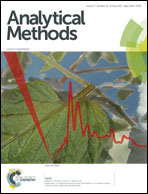Comparison of different analytical classification scenarios: application for the geographical origin of edible palm oil by sterolic (NP) HPLC fingerprinting†
Abstract
This work shows how the best scenario, which applies two chemometric classifiers on different analytical datasets from the same sample set, could be chosen according to the classification results. To this end, several classification quality features such as sensitivity (or recall), specificity, positive (or precision) and negative predictive values, Youden index, positive and negative likelihood ratios, F-measure (or F-score), discriminant power, efficiency (or accuracy), AUC (area under the receiver operating curve), Matthews correlation coefficient, Kappa coefficient, overall agreement probability, overall agreement probability from chance and overall Kappa coefficient are described and discussed. As an application example, two sterolic chromatographic fingerprints obtained from two different normal-phase HPLC systems are used to discern the geographical origin (South-East Asia, West Africa and South America) of edible palm oil. In each case, two conventional and well-known chemometric classification methods are applied: soft independent modelling by class analogy (SIMCA) and partial least squares-discriminant analysis (PLS-DA).


 Please wait while we load your content...
Please wait while we load your content...